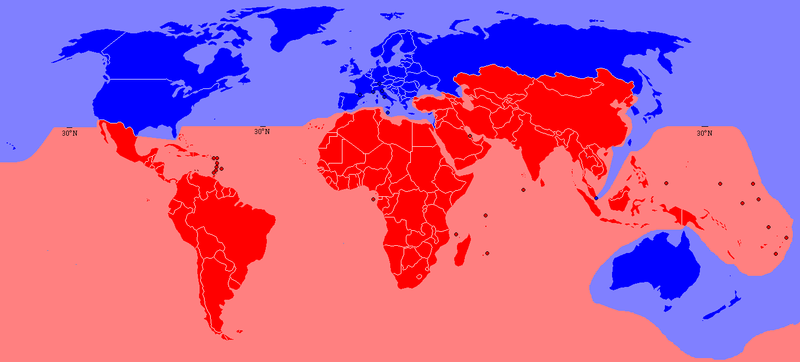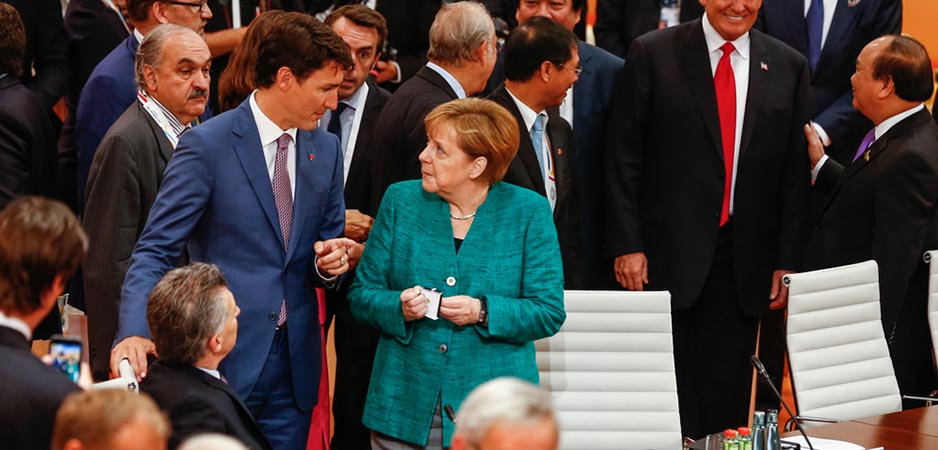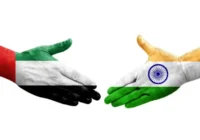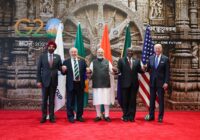[Kanwal Sibal is the former foreign secretary of India. Vikram Sood is the former chief of India’s foreign intelligence agency, the Research and Analysis Wing. Both are noted policy wonks, formidable intellectuals and prolific writers.]
Last year, the World Food Programme (WFP) revealed that “828 million people are unsure of where their next meal is coming from.” This number was for 2021. Since then, this figure has increased. The Russia-Ukraine War has disrupted food and fertilizer production and exports, It has also disrupted supplies of natural gas and oil. So, prices of food, fertilizers and fuel have shot up.
Many poor people simply cannot afford their daily bread, triggering a “seismic hunger crisis.” According to the WFP, a “record 349 million people across 79 countries are facing acute food insecurity – up from 287 million in 2021.” In fact, “more than 900,000 people worldwide are fighting to survive in famine-like conditions.”
India promised to utilize its G20 presidency “to give resonance to the voice of the global south” most affected by current disruptions. Accordingly, it organized the New Delhi “Voice of the Global South” summit in January to “generate ideas from the developing world” on addressing the serious challenges that have arisen over the last year.
What is G20 and what is the Global South?
The G20 website tells us that the Group of Twenty (G20) comprises 19 countries — Argentina, Australia, Brazil, Canada, China, France, Germany, India, Indonesia, Italy, Japan, South Korea, Mexico, Russia, Saudi Arabia, South Africa, Türkiye, the UK and the US — and the EU. The G20 as a whole comprises “around 85% of the global GDP, over 75% of the global trade, and about two-thirds of the world population.”
The Global South is a term used for the poorer parts of Latin America, Asia, Africa, and Oceania. It was previously referred to as the Third World, which has come to be seen as pejorative. Northern regions such as Europe and North America along with their East Asian counterparts such as Japan, South Korea and Taiwan are more prosperous than southern ones. Having said that, Australia and New Zealand may lie in the southern hemisphere but are considered a part of the Global North.
There is a bit more to G20 and the Global South. The former has risen to prominence in the aftermath of two financial crises. In 1997, the Asian financial crisis caused carnage in the world’s biggest continent. From Thailand to South Korea, economies collapsed and, in some countries, according to the great Singaporean statesman Lee Kuan Yew, “the social fabric was torn apart.” This made finance ministers and central bank governors convene in 1999 to form the G20. The 2007-08 financial crisis gave an unexpected boost to the G20. Heads of state got together in the 2008 G20 summit, making it the “premier forum for international economic cooperation.”
Before the 2007-08 crisis, the world’s most advanced economies got together as the G7. This financial meltdown in the US and Europe increased Asia’s importance. Now, Washington, New York, London, Brussels and Berlin needed Asian economies to implement counter-recessionary policies. Most of all, they needed China. Today, the G20 demonstrates this gradual shift in the center of economic gravity to the East. Of the top five economies in the world, three — China, Japan and India — are in Asia. The other two are the US and Germany.
Unlike the clearly defined G20, the Global South is an amorphous entity. When this group of economies were first lumped together, they were a lot poorer. Today, some economies in the Global South rival many in the West for size and complexity. India is one of those economies. India forms both part of the G20 and in the Global South. On the one hand, it is the fifth largest economy in the world with fast-improving infrastructure, a thriving IT sector, a sophisticated pharmaceutical industry and a rapidly growing economy. On the other hand, India’s per capita income was $2,256.6 in 2021 according to the World Bank. Clearly, India is the bridge between the G20 and the Global South.

Bloomberg posits that India could emerge as the global economy’s next powerhouse. India’s strong economic growth and the relative slowdown of many aging G7 economies would make the G20 more relevant. It would play a bigger role in world economic affairs and India could emerge as one of G20’s natural leaders. The Global South would also look to India for leadership just as it did in 1947 when India threw off British colonial yoke and inaugurated the great age of Asian and African independence.
Inclusive Growth for Global South
The Voice of Global South Summit has taken place at a time when headlines about a global recession abound. The World Bank’s Global Economic Prospects published in January talks of growth slowing “to its third-weakest pace in nearly three decades, overshadowed only by the 2009 and 2020 global recessions.” In this scenario, the International Monetary Fund (IMF) has found India to be “a relative bright spot in the world economy.” Even as the Chinese economy is slowing down, top analysts like Martin Wolf of The Financial Times estimate India “should be the fastest growing large economy in the world over the next couple of decades.”
There is more to India than the growth story. Prashant Singhal of Ernst & Young argues that digital infrastructure rollout will transform India. Already, India has put into place Aadhaar, the world’s largest biometric identification system. The government has opened bank accounts for millions and transferred benefits directly to them. The RuPay financial services and payment service system is far more efficient than Mastercard, Visa or any other Western system. It could emerge as a model for many countries in the Global South seeking alternatives to expensive western intermediaries.
India’s response to COVID-19 has emerged as a model for many countries in the Global South. The country was able to develop and manufacture vaccines at scale. As is now recorded in many journals, “India rolled out the world’s largest COVID-19 vaccination drive across 3,006 vaccine centers in all its states and union territories.” This 2021 mass vaccination turned out to be a resounding success. Every citizen’s vaccination was uploaded in a national database that could be accessed easily through an app instead of the primitive reliance on paper in the far more prosperous US. Notably, India’s national vaccination cost a fraction of its American counterpart and had far greater adoption rates.
Through its “Vaccine Maitri” initiative, India supplied “more than 282 million vaccine doses of vaccines to 101 countries and two UN entities.” India also supplied Afghanistan with vaccines despite the Taliban’s hostile attitude to the country. It also sent tens of thousands of tonnes of wheat to Afghanistan, averting famine and a humanitarian disaster in the region. Such generosity has given India a leadership position in the Global South.
The New Delhi summit sought to build upon India’s soft power by stressing South-South Cooperation. The idea underlying this initiative is simple. Poorer countries have a lot to learn from each other whether it is traditional medicine and healthcare systems or vocational training and financial inclusion. A Pavlovian aping of the Global North is unwise, expensive and, at times, even counterproductive. More interaction and greater cohesion among the countries of the Global South is the need of the hour.
India: Connecting Glue in Multipolar World
As retired CIA officer Glenn Carle has said repeatedly, India is a fast-rising global power. What many forget is how India is deeply interconnected with all major powers and key global institutions. India’s biggest economic partner is the US. China, its northern neighbor and strategic rival, is India’s second biggest economic partner. India has a good relationship with EU powers, especially France. Post-Brexit UK and India have concluded six rounds of negotiations for a Free Trade Agreement (FTA).
India has also been deepening its relationships in the Indo-Pacific. The India-Australia FTA came into force on December 22, 2022. The Japan-India relationship has deepened in recent years. Under the leadership of the late Shinzo Abe, Japan developed a special relationship with India. During Abe’s second stint as prime minister from 2012 to 2020, Japan accounted for over 10% of India’s foreign direct investment (FDI). In the coming years, the India-Japan relationship is set to become much stronger.
In a deeply divided world, India has worked hard to engage with different sides. As is now clear, the Russia-Ukraine War has caused tremendous tension to the global system. The US, the EU and NATO support Ukraine against Russia. They have pressured India to fall in line with their position. India has repeatedly called for peace but refused to take sides. New Delhi has sent aid to Ukraine even as it maintains its historic ties with Moscow and buys discounted Russian oil to avert runaway inflation at home.
India participates in multiple international organizations. Few know about India’s loyal service to the UN. Since 1948, more than 200,000 Indians have served in 49 of the 71 UN peacekeeping missions. India is also a part of the Quadrilateral Security Dialogue (Quad), a grouping of four countries — Japan, India, Australia and the US — with an interest in a “free and open Indo-Pacific.” Even as it is a member of the Quad, India is also a member of the Shanghai Cooperation Organization (SCO). In fact, India has recently invited Pakistan’s foreign minister to a SCO summit.
India has navigated its relationships in the tricky Middle East quite skilfully as well. Over the past few years, it has improved relations with Gulf powers such as Saudi Arabia and the United Arab Emirates (UAE). India has also managed to keep its relations with Iran on an even keel. At the same time, India has improved its relationship with Israel. India is now a part of I2U2, a new partnership between India, Israel, the UAE and the US.
The upshot of all the above relationships is simple: India is integral to making our inextricably interconnected, intertwined multipolar world work.
[Kanwal Sibal is the former foreign secretary of India. Vikram Sood is the former chief of India’s foreign intelligence agency, the Research and Analysis Wing. Both are noted policy wonks, formidable intellectuals and prolific writers.]
The views expressed in this article are the author’s own and do not necessarily reflect Fair Observer’s editorial policy.
Support Fair Observer
We rely on your support for our independence, diversity and quality.
For more than 10 years, Fair Observer has been free, fair and independent. No billionaire owns us, no advertisers control us. We are a reader-supported nonprofit. Unlike many other publications, we keep our content free for readers regardless of where they live or whether they can afford to pay. We have no paywalls and no ads.
In the post-truth era of fake news, echo chambers and filter bubbles, we publish a plurality of perspectives from around the world. Anyone can publish with us, but everyone goes through a rigorous editorial process. So, you get fact-checked, well-reasoned content instead of noise.
We publish 2,500+ voices from 90+ countries. We also conduct education and training programs
on subjects ranging from digital media and journalism to writing and critical thinking. This
doesn’t come cheap. Servers, editors, trainers and web developers cost
money.
Please consider supporting us on a regular basis as a recurring donor or a
sustaining member.
Will you support FO’s journalism?
We rely on your support for our independence, diversity and quality.









